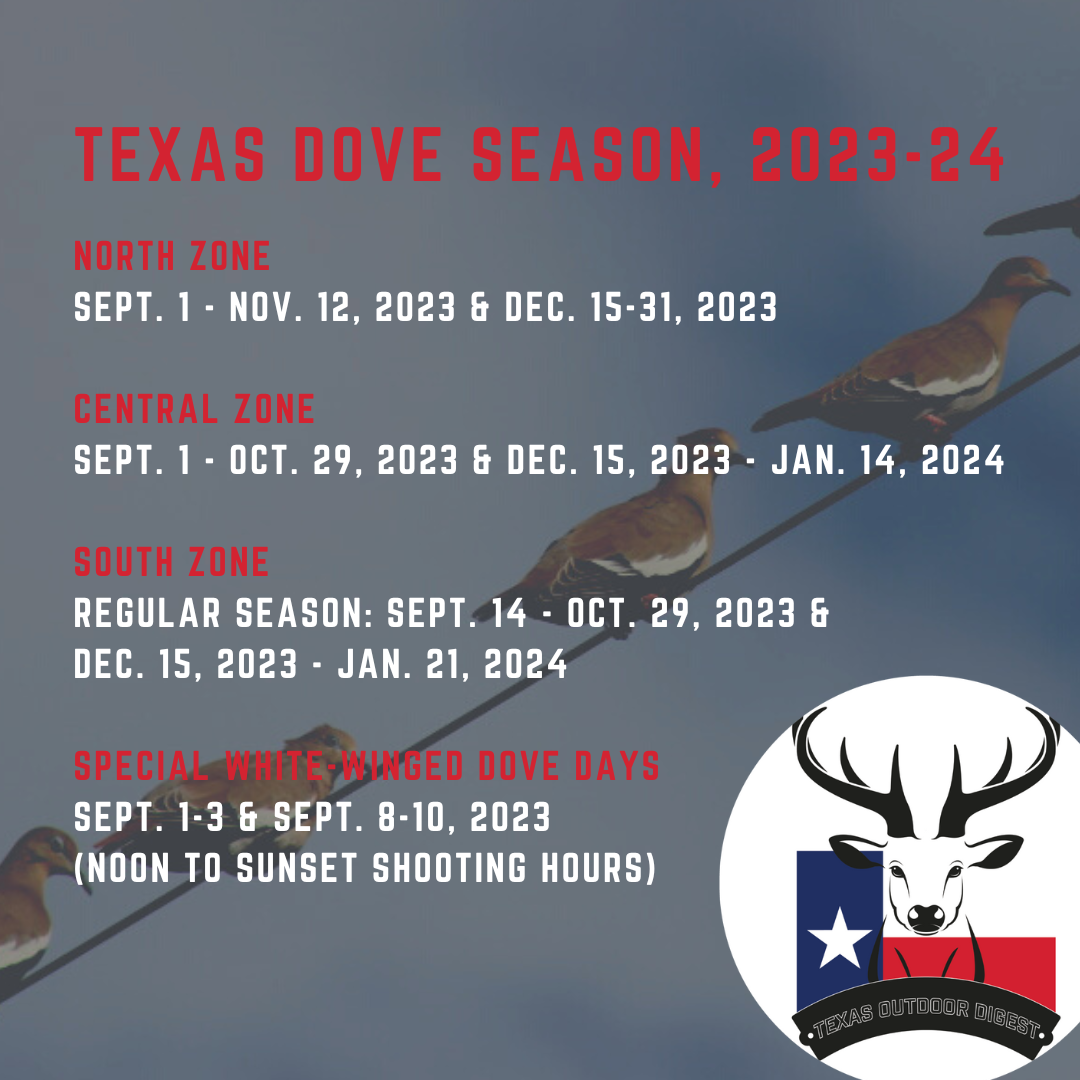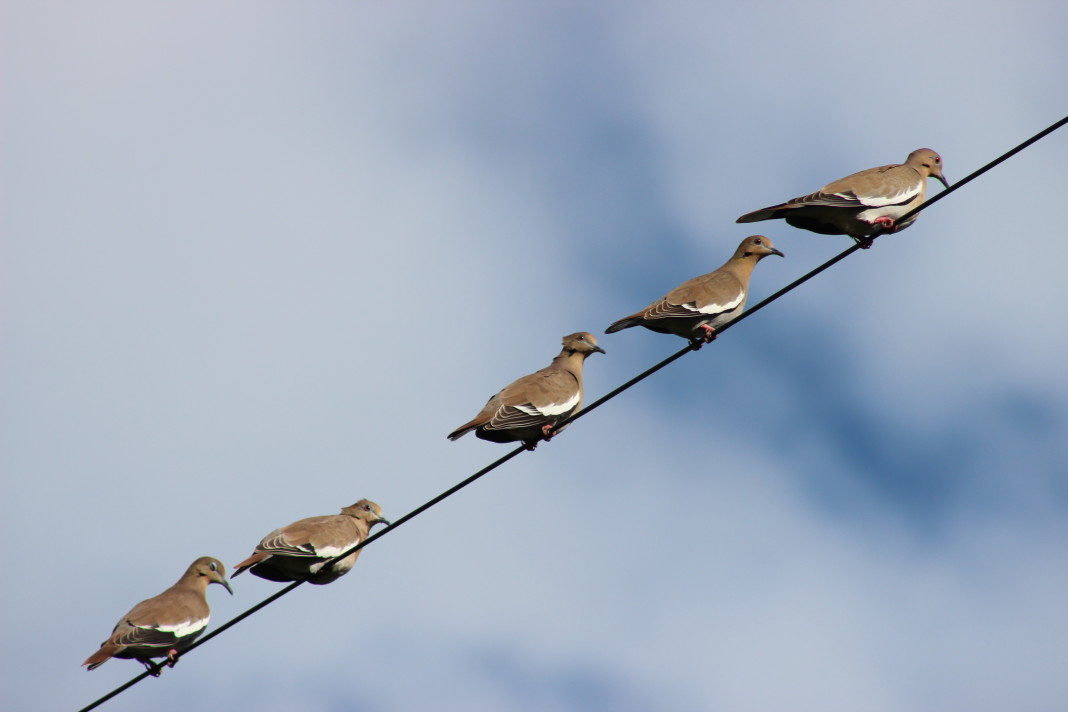
White-winged dove hunting was a “Valley thing.”
Years ago, it was a specialized pursuit that had Texans in metro areas driving 300 or 400 miles one-way to make it down to prized whitewing havens not far from the Mexican border in the Rio Grande Valley to blast at the high-flying quarry.
Then, in the 1980s, the whitewing population slowly started expanding north — first into areas such as Kingsville and Corpus Christi — and later into the southern reaches of San Antonio.
Today, Texas Parks & Wildlife Department biologists are close to declaring whitewings in nearly every one of our 254 counties, with roughly 90% of the breeding population occurring in urban areas.
Simply put, whitewing hunting is now a “Texas thing.”
Sure, there are much higher concentrations of whitewings in South Texas, but it’s not uncommon for hunters in regions to the north to bag a few of these distinctive game birds to go along with the more common mourning doves that fill most bag limits in those locales. In fact, in some places west of Houston, it’s becoming commonplace to find more whitewings than mourning doves, something unheard of 30 or 40 years ago.
Dove hunting in Texas continues to maintain its strong appeal, both signaling the start of fall and winter seasons while providing an affordable opportunity to spend time outdoors. The numbers back it up. Not only does Texas have the highest dove populations in the country, it also boasts the largest number of hunters, according to the U.S. Fish & Wildlife Service. In an average season, roughly a quarter-million people put time in the field hunting mourning doves, while 125,000 target whitewings. Those hunters typically harvest about 5 million mourning doves and almost 2 million whitewings.
That’s a lot of dove breasts that will be doctored up with bacon and jalapeno and charred over a mesquite grill.
Much like the whitewing population, Texas’ public hunting program has grown exponentially during the past three decades, providing an outlet for dove hunters across the state to get their fix, and for cheap, too.
Kelly Edmiston, public hunting coordinator with TPWD, said there are now more than 100 public hunting “units” totaling tens of thousands of acres scattered across the state that can be accessed by those purchasing an Annual Public Hunting permit.
“Our public hunting program started in 1987, focusing mainly on walk-in hunting opportunities on wildlife management areas and even some state parks,” Edmiston said. “We even leased land from timber companies for some public hunting and in 1988 TPWD formed a partnership with the Forest Service to lease more new areas for hunters.”
Edmiston said that one particular game bird has helped provide a big draw each year: doves.
“In 1994, we started a pilot program for public hunters, focusing specifically on doves but also other small game species,” Edmiston said. “TPWD went out and looked for landowners willing to lease tracts within a short drive from metropolitan areas. We used proceeds from the sale of the Annual Public Hunting permit, which at the time was $35, to lease more lands from private landowners that could be used for dove hunting. I think that first year we had about 10 areas but it was the start of something larger.
“All along, the public dove hunting we’ve offered has been geared toward urban hunters. Maybe it’s that hunter who can get off work early and take their kids out dove hunting and help pass the tradition on. That first year was focused mostly on areas within that I-35 corridor in either the Austin or San Antonio areas. And while we wanted to find more areas to lease for hunting, we also were focused on showing landowners that leasing land for hunting was a good thing, something that’s not intimidating.”
Texas dove hunting forecast good heading toward September staple
Edmiston said that there are numerous benefits associated with the public hunting program, and not just for hunters.
“Today we have about 120 areas throughout the state that are leased for public hunting, still mostly on those major metro corridors,” Edmiston said. “Every year, we send biologists into the field, looking for new areas and contacting landowners to inquire about leasing their land for small game hunting. That includes doves, but also quail, waterfowl and even pheasants up in the Rolling Plains and Panhandle.
“What landowners quickly learn is that leasing land for public hunting is a great way to supplement their incomes and efforts. We’ve got a lot of folks that may only offer dove hunting during the first split because they’ve got cattle to work or crops to plant during the rest of the year.”
Because of the economic impact of dove hunting in Texas — estimated at roughly $300 million annually — it’s easy to be optimistic each fall about lies ahead.
“The public hunting program, especially for doves, also helps out the little communities in and around our public hunting areas,” Edmiston said. “Many of those little towns and stores see a bunch of business come in the door in September and October when all those dove hunters are out. That’s good for them.”
Edmiston noted there’s a wealth of information available for hunters looking to maximize their efforts on public lands, perhaps even finding a spot that might not get as much hunting pressure.
“When you purchase an Annual Hunting Permit, which becomes available Aug. 15 — the same date as hunting licenses — you will get a booklet (roughly 180 pages) that includes map of all the tract in the public hunting program, with listings for species that can be hunted and when, and the regulations that each tract is under,” Edmiston said. “There’s also a digital version online on our website, which includes aerial maps of the areas, which can help provide a little more detail.”
Wildlife Management Area Public Dove Hunts
Here are five Wildlife Management Areas spread across the state that provide excellent dove hunting, including for an expanding whitewing population:
South Texas: Chaparral Wildlife Management Area
The “Chap” is a deer-hunting hot spot situated just southwest of Cotulla, but its 15,000 acres include great hunts for birds and other game, too. While deer, javelina and feral hog hunts are by drawing only, the WMA offers public hunt access for white-winged doves and mourning doves as well as quail.
Rio Grande Valley: Las Palomas Wildlife Management Area
Las Palomas, unlike some other WMAs in other parts of Texas, is a combination of different tracts that aren’t connected. The one that typically draws the most attention from hunters is the Arroyo Colorado Unit, a roughly 900-acre tract in Cameron County just northeast of Harlingen. This is the prime hot spot for public white-winged dove hunting in the Lone Star State, featuring excellent native habitat.
Gulf Coast: Justin Hurst Wildlife Management Area
Hurst WMA, located west of Freeport in Brazoria County, is named for a game warden who was killed in the line of duty in 2007 after a high-speed chase. The WMA is among the top public waterfowl hunting haunts in Texas, but it also offers good dove hunting opportunities. It should be noted that dove hunting must be done using non-toxic shot.
Rolling Plains: Matador Wildlife Management Area
This 28,000-acre area southwest of Childress near the Oklahoma border is well-known for its deer opportunities and annually produces multiple whitetail bucks exceeding 150 Boone & Crockett points and mule deer surpassing 160 B & C for public hunters. The area also offers excellent dove hunting, especially in years with average to good rainfall, and hunters annually find similarly good shoots for quail and early teal.
North Texas: Tawakoni Wildlife Management Area
With a waterfowl hunting area encompassing more than 36,000 acres, Tawakoni is a duck hunting haven, with more open dates than other WMAs. The lake east of the Dallas-Fort Worth Metroplex also is a draw for doves and dove hunters. In addition, all-day hunting is allowed for the early teal season running in early September.
2023-24 Texas Dove Seasons
North Zone: Sept. 1 – Nov. 12, 2023 & Dec. 15 – 31, 2023
Central Zone: Sept. 1 – Oct. 29, 2023 & Dec. 15, 2023 – Jan. 14, 2024
Special White-winged Dove Days (entire South Zone): Sept. 1-3 and Sept. 8-10 (special regulations apply)
South Zone, Regular Season: Sept. 14 – Oct. 29, 2023; Dec. 15, 2023 – Jan. 21, 2024
The daily bag limit for doves statewide is 15 and the possession limit 45.
During the early two weekends for the Special White-Winged Dove Days in the South Zone, hunting is allowed only from noon to sunset and the daily bag limit is 15 birds, to include not more than two mourning doves and two white-tipped doves. During the general season in the South Zone, the aggregate bag limit is 15 with no more than two white-tipped doves.



















Appreciating the time and effort you put into your website and in depth information you offer. Thanks for sharing this informative post!